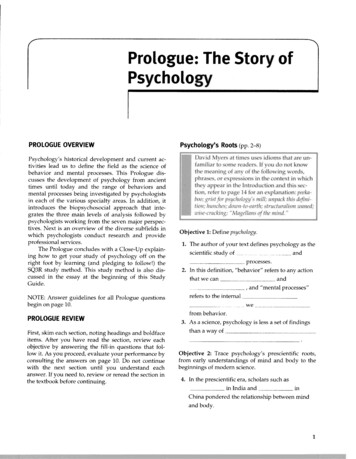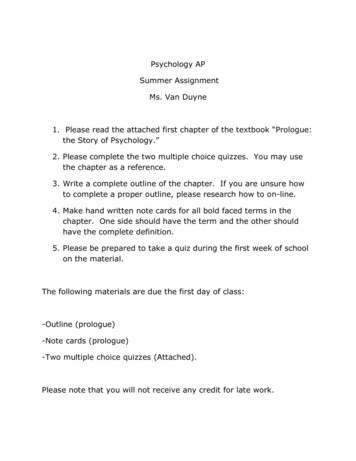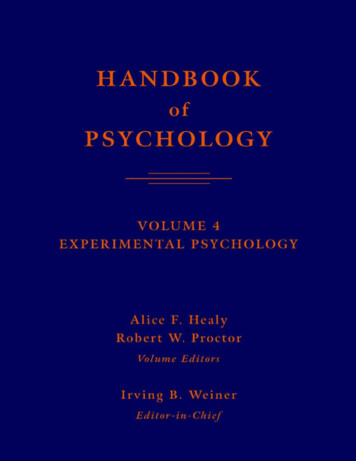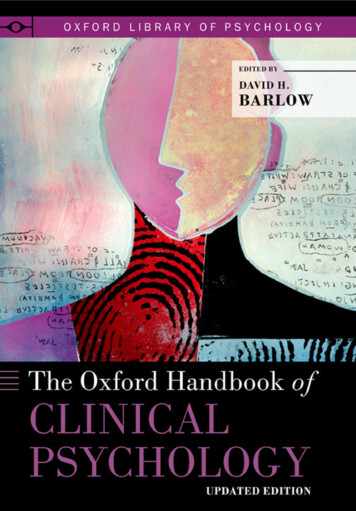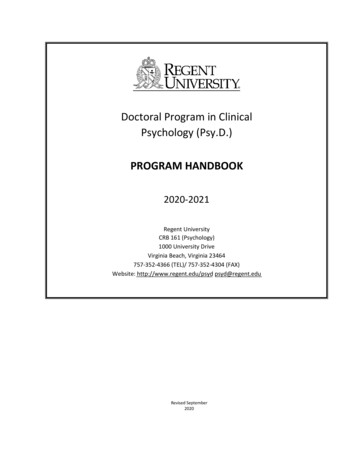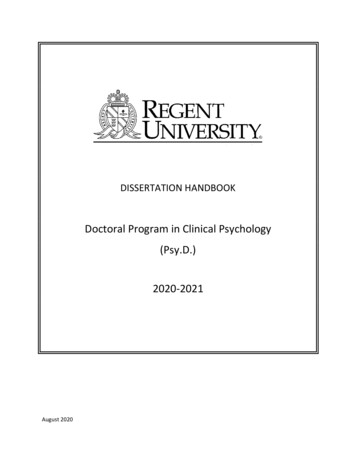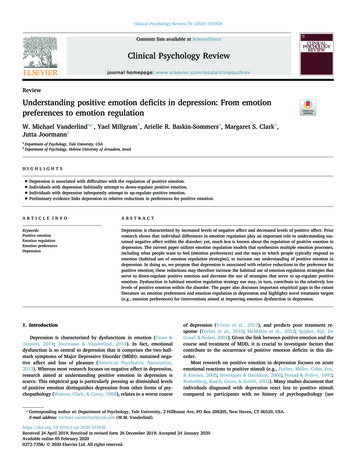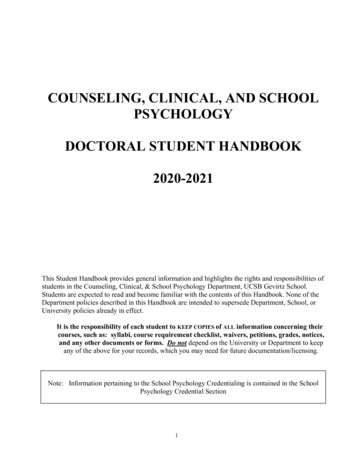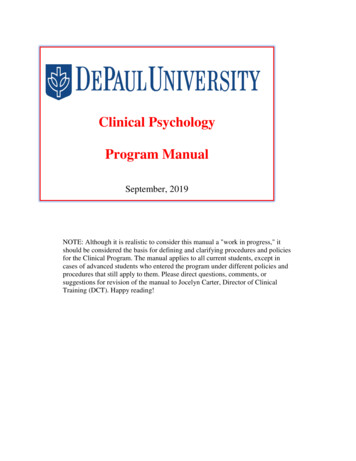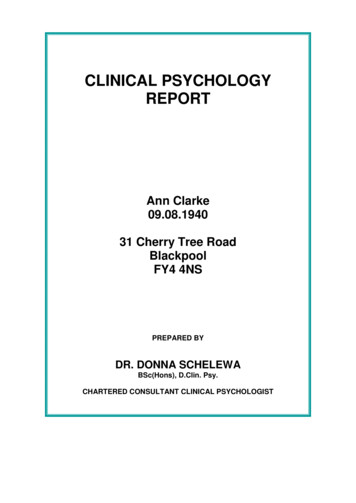
Transcription
CLINICAL PSYCHOLOGYREPORTAnn Clarke09.08.194031 Cherry Tree RoadBlackpoolFY4 4NSPREPARED BYDR. DONNA SCHELEWABSc(Hons), D.Clin. Psy.CHARTERED CONSULTANT CLINICAL PSYCHOLOGIST
SECTION 1INTRODUCTIONINSTRUCTIONSNATURE OF INVESTIGATIONSOURCES OF INFORMATION2
[1] INTRODUCTION[1.1] Dr. Donna SchelewaI am Dr. Donna Schelewa, the principal Consultant Clinical Psychologist in HXIConsulting, a private Chartered Clinical Psychology Practice. HXI Consultingprovides research, assessment and therapeutic services across health and legalcontexts.I am a member of the British Psychological Society and the Division of ClinicalPsychology. I am a Chartered Clinical Psychologist and I am also regulated by theHealth Professions Council. My qualifications include a BSc (Hons) degree inApplied Psychology, a Doctorate in Clinical Psychology and Post GraduateDiploma in Consultative Supervision. I am qualified to use a broad portfolio ofpsychometric tests and clinical procedures assessing cognitive capacity,personality, and symptomatology and psychopathology in adults. I have twentyyears experience in the field of clinical psychology and my current NHS post is asHead of Psychology Services for Carmarthenshire.3
[1.2] INSTRUCTIONS[1.2.1] I have been instructed to prepare a report in respect of Mrs. Ann Clarke.The specific instructions are as follows:[1.2.2] Please undertake a generalised/global neuropsychological assessmentof Ann Clarke.[1.2.3] Please produce a report and consider:1. Her capacity to decide on where and with whom to live.2. Her capacity to manage a small income of 500 weekly.3. Her capacity to loan, lend or spend her income weekly as she see‘s fit.4. Her capacity to make a will.4
[1.3]NATURE OF INVESTIGATION[1.3.1] The Investigation involved the following:- Neuropsychological assessment of Ann Clarke- Capacity Assessments of Ann Clarke[1.4] SOURCES OF INFORMATION[1.4.1] No documents were received with the letter of Instruction. The findings inthis report are based solely upon a neuropsychological and capacityassessment of Ann Clarke. Mrs. Clarke‘s medical records were requested butnot supplied.5
SECTION 2ASSESSMENT OFAnn Clarke6
Client DetailsCLIENT 1:NAME:ANN CLARKEADDRESS:31 CHERRY TREE ROADBLACKPOOLFY4 4NSDATE OF BIRTH: 09.08.1940AGE:70 YEARS 4 MONTHSDATE OFASSESSMENT:27.11.2010REPORT DATE:20.12.20107
[2.0]ANN CLARKE - OVERVIEW & BACKGROUND[2.0.1] Personal and Social History: Mrs. Clarke‘s son Michael provided a briefsocial history for his mother. He reported that he was one of three children andthat his mother Mrs. Clarke has lived predominantly with him since 1995. Hestated that his mother had attempted suicide in 1995 following a prolongedperiod of depression. Mrs. Clarke was reportedly hit by a wagon and sustainedsevere left hemisphere brain damage. Since this time, it was reported that shehas lived predominantly with her son Michael who has assumed the main carerrole.[2.0.2] Description of Current Circumstances: It was reported that Mrs. Clarkehad become concerned that she may be forced to live elsewhere other thanwith her son Michael. This reportedly was causing her significant concern.Therefore it was arranged for her to engage in a neuropsychological andcapacity assessment to consider her ability to make her own decisionsregarding her future.8
[2.1.0] ASSESSMENT OF PSYCHOLOGICAL WELLBEING[2.1.1.] The Beck Depression Inventory (BDI-II).This is a 21-question multiple-choice self-report inventory that is one of the mostwidely used instruments for measuring the severity of depression. The mostcurrent version of the questionnaire is designed for individuals aged 13 andover and is composed of items relating to depression symptoms such ashopelessness and irritability, cognitions such as guilt, or feelings of beingpunished, as well as physical symptoms such as fatigue, weight loss, and lackof interest in sex. There are three versions of the BDI—the original BDI, firstpublished in 1961 and later revised in 1978 as the BDI-1A, and the BDI-II,published in 1996. The BDI is widely used as an assessment tool by healthcareprofessionals and researchers in a variety of settings.Mrs. Clarke‘s score 14 - this places her within the non clinical range andsuggests that she does not present with symptoms consistent with a diagnosisof depression.9
[2.1.2] The Beck Anxiety Inventory (BAI).The Beck Anxiety Inventory (BAI), created by Dr. Aaron T. Beck, is a 21question multiple-choice self-report inventory that is used for measuring theseverity of an individual's anxiety or levels of stress. It has been used in avariety of different patient groups, including adolescents and elderly patients.Mrs. Clarke‘s score 11 - This places her within the non-clinical range andsuggests that she does not present with symptoms consistent with a diagnosisof anxiety.[2.1.3] The Beck Hopelessness Scale (BHS)The Beck Hopelessness Scale (BHS) is a 20-item scale for measuring negativeattitudes about the future. Beck originally developed this scale in order topredict who would commit suicide and who would not. The BHS isrecommended for measuring extent of negative attitudes in clinical andresearch settings.Mrs. Clarke‘s score 4 - This places her within the non clinical range andsuggests that she does not perceive her situation to be hopeless. High scoreson this scale correlate with self harming behaviour.10
[2.2.0] NEUROPSYCHOLOGICAL ASSESSMENT[2.2.1] A neuropsychological assessment is traditionally carried out to assessthe extent of impairment to a particular cognitive skill and to attempt to locate anarea of the brain which may have been damaged after brain injury orneurological illness. A comprehensive neuropsychological assessment wascompleted with Mrs. Clarke.[2.3.0] TEST ADMINISTERED[2.3.1] Kaplan Baycrest Neurocognitive Assessment (KBNA)This comprehensive screening tool combines behavioural neurology andtraditional neuropsychological approaches to assessment. The KBNA providesimportant information that can be used for a general overview, in-depthdiagnosis, or treatment planning and monitoring. The battery comprisessubtests that focus on these major areas of cognition: Attention/Concentration Reasoning/Conceptual Shift Verbal Fluency Language Praxis Spatial Processing Immediate Memory Recall Delayed Memory Recall Delayed Memory Recognition Expression of Emotion11
[2.3.2] Organisation of the KBNA: Each of the KBNA subtests were constructedto measure specific aspects of neurocognitive functioning. The purpose of thesesubtests is to determine whether an individual‘s neurocognitive performance isin the average, equivocal or below average range. Mrs. Clarke attained thefollowing results on the KBNA subtests:1. Orientation: The orientation subtest is composed of a series of questionsthat tap the examiner‘s knowledge of the current date and time,geographic location and personal information. The domain of cognitivefunctioning is the individual‘s declarative memory for personally relevantinformation.2. Sequences: The sequences subtest is a collection of mental-controltasks that tap selective attention. For one task, the examinee is requiredto recite the months of the year in the normal sequence and then torecite the months in reverse sequence. For individuals with expressivedysphasia, they are asked to point to cards with the months of the yearwritten on them in the correct sequence and then in reverse order.3. Numbers: This is a measure of primary memory. The examinee is askedto recall a set of telephone numbers in two oral response trials and onewritten-response trial.12
4. Word Lists 1 and 2: The Word Lists subtests tap into the examinee‘sability to learn and remember a list of twelve words. Word List 1 is theimmediate free recall5. Complex Figure 1 and 2: This subtest consists of two components: copyand immediate free recall. This task is a measure of spatial appreciationand spatial memory.6. Motor programming: For this subtest the examinee is asked to open andclose each hand simultaneously and oppositionally. This subtest is ameans of assessing the examinee‘s praxis and the production ofsimultaneous, co-ordinated movements.7. Auditory Signal detection: For this subtest that examinee listens to a taperecording of alphabet letters in random order, and signals, by tapping thetable, each time he or she hears the letter A. The letters are read at therate of one per second. This subtest is a measure of selective attentionand sustained attention.8. Symbol Cancellation: For Symbol Cancellation, the examinee ispresented a page with over 200 geometric figures and is asked to circlethe figures that match a designated target. The task is a measure ofselective and sustained attention.13
9. Clocks: The Clocks subtest consists of five components: free drawing,predrawn copy, reading without numbers and reading with numbers. Thesubtest measures semantic memory and visuospatial memory.10. Picture naming: Picture naming requires the examinee to name objectsdepicted in black and white line drawings. If the examinee does notrecognise an object, he/she is given a semantic cue. If the examineerecognises the object but cannot spontaneously name it he/she is givena phonetic cue. The principal domain of focus is language naming, butthe subtest also taps into visuoperceptual memory.11. Sentence Reading-Arithmetic: This subtest serves a dual purpose. Thefirst task requires the examinee to read aloud two math problems and istherefore a measure of reading ability. The second part of the subtestconsists of nine math problems requiring addition, subtraction ormultiplication.12. Reading Single Words: This subtest requires the examinee to read alouda set of ten words and five nonsense words. This allows the clinician toevaluate the examinee‘s ability to use phonetic decoding instead ofvisuospatial memory.13. Spatial Location: For this subtest, the examinee is presented with aseries of figures, and is then required to place circular chips on a matrixto replicate the array of dots in the stimulus figure. This subtest taps intothe examinee‘s spatial memory.14
14. Verbal Fluency: This subtest has three components. The first is a task oflanguage expression, the second is considered to be a measure oflanguage naming and verbal semantic memory and the third task taps into language naming.15. Praxis: This subtest is divided in to tests of ideomotor praxis cofacialmovements. These tasks are a means of assessing praxis control andare accepted as tasks of ideomotor apraxia. Ideomotor apraxia oftenoccurs after damage to the language dominant hemisphere. Limbapraxia is far more common than buccofacial apraxia, but nstratestheexaminee‘s ability to follow instructions.16. Picture Recognition: For this subtest the examinee is shown a series ofblack and white line drawings, twenty of which are identical to thosepresented in the Picture naming subtest and twenty that are newpictures. The domains involved in this subtest are episodic memoryconsolidation and visuospatial memory. It is very useful with aphasics forwhom the results of verbal memory tests are often contaminated by theeffects of impaired verbal encoding or retrieval.17. Expression of Emotion: This subtest requires the examinee todemonstrate four facial expressions that represent anger, sadness,happiness and surprise. The targeted domain is emotive expression.15
18. Conceptual Shifting: This consists of a series of cards, each with a set ofline drawings that share similar attributes. The examinee is asked toindicate, by pointing the number corresponding to each design, whichthree designs are alike. This task is a means of assessing functioning orgeneralisability and cognitive flexibility.19. Picture description – Oral: The examinee is required to describe a sceneusing complete sentences. This task measures descriptive discourse,verbal fluency and language naming.20. Auditory Comprehension: For this subtest the examinee is read fivequestions that require yes or no responses. The test is a measure oflanguage comprehension.21. Repetition: This subtest requires the examinee to repeat verbatim fiveitems read aloud by the examiner. The task is a measure of languagecomprehension.16
[2.4.0] ASSESSMENT OUTCOMEMrs. Clarke‘s performance on the KBNA was scored and her results are asfollows:[2.4.1] Results: Raw and Scaled ScoresSubtestRaw ScoreScaled Score(Where provided)OrientationSequencesNumbersWord ListsComplex Figure 1Motor ProgrammingAuditory Signal detectionSymbol CancellationClocksWord Lists 28/13283/94/48113/419/2247/6021/37Free recallRecognitionComplex Figure 2 RecognitionPicture Naming12262/20Phonemic CuesSentence Reading-Arithmetic11/20Reading AccuracyArithmetic ScoreReading Single WordsSpatial LocationVerbal Fluency0/43/110/15285218214Semantic ScorePhonemic ScorePraxisIntransitive MovementsTransitive MovementsBuccofacial MovementsPicture RecognitionExpression of eptual ShiftingPicture Description- OralAuditory 17
[2.4.1] Results: Index ScoresIndexIndex ScorePercentileAttention/Concentration23 1Memory – Immediate313271334Spatial Processing327Verbal Fluency17 1Reasoning/Conceptual00recallMemory – DelayedRecallMemory - DelayedRecognitionShift[2.4.2] Summary of Results: Mrs Clarke attained a range of scores on the KBNAthat are now discussed in more detail:Subtest: Orientation - This subtest measures an individual‘s declarative memoryfor personally relevant information. Mrs. Clarke attained a score of 8/13.However, due to her evident expressive dysphasia, she required assistance inthe form of a range of written and verbally presented answers that she couldselect from. These were read aloud to her and she selected the answer that sheperceived was the correct one. The domain of cognitive fun
this report are based solely upon a neuropsychological and capacity assessment of Ann Clarke. Mrs. Clarke‘s medical records were requested but not supplied. 6 SECTION 2 ASSESSMENT OF Ann Clarke. 7 Client Details CLIENT 1: NAME: ANN CLARKE ADDRESS: 31 CHERRY TREE ROAD BLACKPOOL FY4 4NS DATE OF BIRTH: 09.08.1940 AGE: 70 YEARS 4 MONTHS DATE OF ASSESSMENT: 27.11.2010 REPORT

